Jean-Louis Pons facts for kids
Quick facts for kids
Jean-Louis Pons
|
|
|---|---|

Jean-Louis Pons
|
|
| Born | 24 December 1761 Peyre, France
|
| Died | 14 October 1831 (aged 69) |
| Awards | Lalande Prize (1818, 1820, 1827) |
| Scientific career | |
| Fields | Astronomy |
Jean-Louis Pons (born December 24, 1761 – died October 14, 1831) was a French astronomer. He came from a poor family and taught himself astronomy. Even so, he became the best comet discoverer ever! Between 1801 and 1827, Pons found 37 comets. No one else has found more.
Pons worked at three different observatories during his life. He started at Marseille Observatory, where he also learned about astronomy. Later, he worked at an observatory in Tuscany and then in Florence. His discoveries helped astronomers find famous comets again, like Encke's Comet. Most of the comets he found travel on paths that mean they won't come back for thousands of years.
Contents
Jean-Louis Pons's Early Life
Jean-Louis Pons was born in Peyre, Hautes-Alpes, France. His family was poor, and he did not get much schooling. In 1789, he started working at the Marseille Observatory. He was a caretaker there.
Slowly, he learned by helping the astronomers with their observations. He became very good at watching the stars himself. Pons had an amazing skill: he could remember star fields and notice any changes in them.
When he was starting out, some older astronomers would play jokes on him. One time, Franz Xaver von Zach told him to look for comets when sunspots were out. This might have actually been good advice for Pons!
Pons's Astronomy Career
Pons found his first comet on July 11, 1801. He shared this discovery with Charles Messier. Pons seemed to use telescopes that he designed himself. His special telescope, called the "Grand Chercheur" (which means "Great Seeker"), had a wide opening and a short length. It was like a "comet seeker" telescope.
Pons was not always careful about writing down his observations. His notes were often very unclear. Still, he found about 75% of all comets discovered during this time! In 1813, he became an Assistant Astronomer at Marseille Observatory.
In 1819, Pons became the director of a new observatory in Marlia, near Lucca. He left there in 1825 to teach astronomy at La Specola in Florence. Around that time, the Grand Duke of Tuscany asked him to become the Director of the Florence Observatory. Pons accepted this important job.
Famous Comets Pons Discovered
Pons discovered five periodic comets. Periodic comets are those that return to our solar system regularly. Three of these comets are named after him:
- 7P/Pons–Winnecke
- 12P/Pons–Brooks
- 273P/Pons–Gambart
One comet he saw on November 26, 1818, was named Comet Encke (now called 2P/Encke). This was named after Johann Franz Encke. Encke figured out its orbit and its very short period of 3.3 years. Even so, Encke often still called it "Pons's Comet."
Pons also helped discover a comet once known as "Pons–Coggia–Winnecke–Forbes." Today, it is called 27P/Crommelin. It was renamed after Andrew Crommelin, who calculated its path.
Awards and Recognition
The French Academy of Sciences gave Pons the Lalande Prize in 1818. He won it for finding three comets that year. He won it again in 1820 for more comet discoveries. He shared this prize with Joseph Nicollet.
Pons won the Lalande Prize a third time in 1827. This was a rare achievement! He shared this prize with Jean-Félix Adolphe Gambart. They won for finding seven more comets at the Florence observatory.
By 1827, Pons's eyesight started to get worse. He stopped observing completely shortly before he passed away. He died on October 14, 1831. To honor him, a Moon crater was named after him.
Pons's Comet Discovery Record
Jean-Louis Pons is famous for discovering 37 comets in the early 1800s. As of 1960, this was the most comets ever found by one person.
Out of the 37 comets, 28 were found to have parabolic orbits. This means they travel on paths that do not bring them back to the inner solar system often. For three of his discoveries, there were not enough observations to figure out their orbits.
However, many of his discoveries helped lead to finding or re-finding comets that later became known as periodic comets. These include Comet Pons-Brooks and Comet Pons-Winnecke. The comet 273P/Pons–Gambart, which Pons saw in 1827, was seen again in 2012.
See also
 In Spanish: Jean-Louis Pons para niños
In Spanish: Jean-Louis Pons para niños

